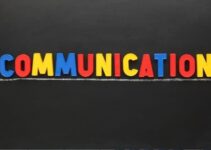What is Communication?
Effective communication is central to the success of any business organization. Communication is a pervasive activity which encompasses almost all facets of our lives. Much of our life is spent communicating with each other, be it at our workplace or in our family life.
The term communication is derived from the Latin word ‘communis’ which means common. Thus, communication involves rendering common ideas, opinions or information, that is, the sharing of ideas opinions or information.
Communication is defined as the interchange of thought or information between two or more persons to bring about mutual understanding.
Robert Anderson has defined communication as the interchange of thoughts, opinions or information by speech writing or signs.
According to Louis, ‘Communication is the sum of all things one person does when he wants to create understanding in the mind of another; it involves a systematic and continuous process of telling, listening, and understanding.‘
Keith Davis has defined communication as the transfer of information and understanding from one person to another person. It is a way of reaching others with facts, ideas, thoughts, and values.
In the words of Peter Little, ‘Communication is the process by which information is transmitted between individuals and/or organizations so that an understanding and response develops.‘
When communication is referred to in an organizational context, it is known as organizational communication. According to William Scott: ‘Administrative communication is a process which involves the transmission and accurate replication of ideas ensured by feedback for the purpose of eliciting actions which will accomplish organizational goals.‘
Characteristics of Communication
Based on the above definitions there are certain characteristics of communication. These are:
- Communication involves at least two persons-the senders and the receiver.
- It involves the transfer of ideas, facts, emotions, gestures, symbols, and action from sender to receiver.
- Understanding is an essential component of communication, that is, the ideas, opinions, emotions and so on, conveyed should be accurately replicated in the receivers’ mind.
- Communication may be intentional or unintentional.
- The purpose of communication is to elicit action, inform or to express a certain point of view.
- Communication is a two-way process, that is, feedback from the receiver to the sender is an essential component of communication.
- Communication is a dynamic process, that is, it grows and develops.
- Communication is systematic, that is, every component of the process is affected by every other component. For example, if there is a fault in the telephone (channel of communication), it will affect the message received by the receiver.
Classification of Communication
Communication in an organization can be broadly classified into two types:
- Formal Communication
- Informal Communication
This classification is based on channels of communication. The channel of communication refers to the path through which the information is transmitted
Formal Communication
Formal communication refers to the official communication which follows the formal channel. Formal channels are the paths of communication that are institutionally determined, that is, they are established by the organization. This communication follows the scalar chain of command.
Formal communication can be oral or written. Oral communication can take the form of interviews, meetings, presentations, and so on. Written communication can take the form of notes, memos, letters, reports, and so on.
Formal communication can be further classified into the following:
- Downward communication: It refers to communication from top-level managers to middle or lower-level managers. Any communication that moves from employees to supervisors, supervisors to managers, managers to executives, regional manager to general manager and so on, maybe categorized as upward communication.
- Upward communication: It refers to communication from lower-level managers to top-level managers. It travels through senior executives to junior level functionaries, from the controlling office to the branch, from the head of the division to the head of the unit.
- Horizontal or Lateral communication: Lateral communication generally takes place in an organization and is neither upward nor downward. It proceeds in a horizontal manner and takes place among equals and at peer level.
- Interactive communication: Interactive communication is essentially a two-way process. It takes place through meetings, conferences, teleconferencing, multimedia presentations, group discussions, and other such active two-way exchanges.
Informal Communication
Informal communication refers to communication between individuals and groups, which does not follow the official recognized channel. It is a result of social interaction among the various members of the organization. The transfer of information may be related to work or other matters and it cuts across official lines of communication.
The network or pathway of informal communication is called grapevine. The untrue part of the grapevine is called rumor. The following are some of the characteristics of grapevine:
- In grapevine, the flow of information takes place in all directions.
- Transmission of the information is rapid because the chain of command is not followed.
- It is selective about people who receive the information.
- It extends beyond the formal hierarchy system.






